79th Field Hospital Unit History

Training and caring for a patient in the field. The aim was to give the personnel as much practice as possible while training in the Zone of Interior.
Introduction & Activation:
The 79th Field Hospital was originally activated at 0001 hours, 21 September 1944 under T/O & E 8-510, dated 28 September 1943, with Change, Circular 201, War Department 1944, at Camp Ellis, Table Grove, Illinois (Army Service Forces Training Center; acreage 17,503; troop capacity 1,795 Officers and 24,654 Enlisted Men –ed), as per General Orders # 1, Headquarters, Army Service Forces Training Center, Camp Ellis, Illinois, dated 10 August 1944, and per General Orders # 1, this organization, dated 21 September 1944.
Organization:
At the time, the unit consisted of 5 Officers and 149 Enlisted Men;
The five (5) Officers were as follows:
- Lt. Colonel Harvey E. GAYNES, MC, O-346074 > Commanding Officer
- Lt. Colonel Thomas R. STUART, Jr., MAC, O-1533686 > Adjutant
- 1st Lieutenant Sidney S. COHN, DC, O-544794 > Dental Officer
- 1st Lieutenant Hubert W. GRIESS, MAC, O-337956 > Medical Supply Officer
- 1st Lieutenant William F. MOORE, Jr., ChC, O-555728 > Chaplain

Fort Knox, Kentucky, December 1944. From L to R: 1st Lieutenant Sidney S. Cohn, DC; 1st Lieutenant S. Leventhal, MC; 1st Lieutenant W. Koch, MC. Picture taken while training at Fort Knox.
Although the men had already been training at Camp Ellis, Table Grove, Illinois, for approximately four (4) months, the morale appeared to be excellent. In order to expedite unit training, 116 Enlisted Men were sent on POM furloughs, and all Officers, excepting 1st Lieutenant H. W. Griess, started on leave.
On 22 September 1944, Sergeant Benjamin B. Pessin, 37058211, and Sergeant Calvin L. Swisher, 36533778, were assigned to the organization and immediately sent on furlough. Five (5) more EM were assigned and joined from the 28th Medical Training Regiment, Camp Ellis, Illinois. After arrival of the additional personnel and equipment, two (2) ward tents were erected for use as warehouses for supplies.
More men arrived in the form of 26 Enlisted personnel, also coming from the 28th Medical Training Regiment (Camp Ellis). They also left on furlough. On 25 September more supplies came in through the Quartermaster, and 30 more men left on furlough. Another NCO, Sergeant Clair F. Tibbals, 36531082, arrived at Camp Ellis and was sent on furlough. On 29 September 1944 a first inspection took place by Officers of the Medical Corps and 2 additional Officers were assigned to the organization. They were: 1st Lieutenant Vernon L. Nickel, MC, O-1786922 and Captain James G. Economon, MC, O-485610.
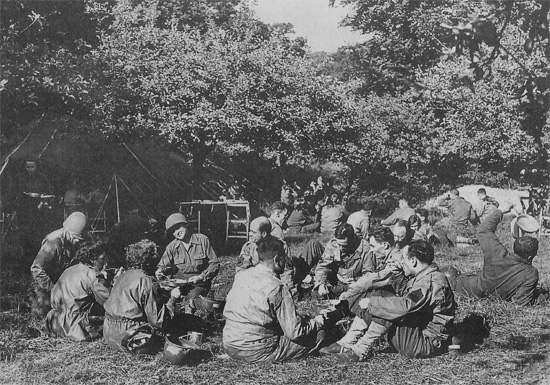
Field training included setting up bivouac, and getting established in the field. These exercises were often organized under total blackout conditions …
Training:
All Officers and 111 EM returned from furloughs, leaving only 5 men AWOL. A new training program was started 9 October 1944, including a review of basic subjects. Two carloads of organizational equipment came in. Consequently, two empty barracks and one empty room were taken over as temporary warehouses. By 10 October, all AWOL personnel had reported in late. Military discipline was expected to improve, and as there were too many liberties, some measures were taken to implement this. Corporal James K. Dye was reduced to the grade of Private for driving to town without proper authorization. Another measure to improve discipline was to send the 79th on bivouac 23 October 1944! It would also allow to process the Enlisted personnel and complete the service records.
On 12 October, a complete eye survey was made on all EM. As some equipment, such as the field ranges, had not yet arrived, the bivouac date was postponed. A new T/O & E came in, meaning considerable changes were to be implemented. A showdown inspection of the entire Enlisted Men personnel took place 13 October. It was followed by meetings and discussions regarding bivouac training, program, site, and supplies to be used. Practice was given in black-out tent pitching. Lectures took place, Army Regulations were discussed, and individual physical disabilities examined. Several personnel changes due to the new T/O & E were deemed necessary. All EM received smallpox vaccination on 14 October 1944. The Post Inspector and team visited the unit, examining and scrutinizing personnel records – sick books – daily morning reports – service records, etc. The session was followed by a POM film for all Enlisted Men. Meanwhile the CO carried out a reconnaissance of the bivouac area and arrangements.
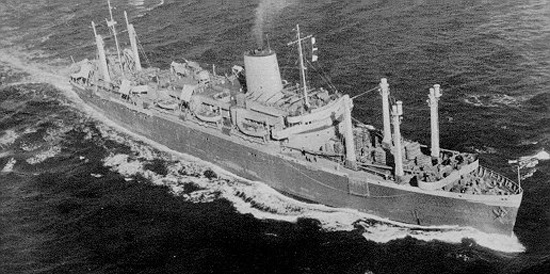
Photograph of the USAT “Cristobal”. The vessel started its journey across the Atlantic on 26 December 1944 with the 79th Field Hospital on board for service in the European Theater of Operations (first destination: United Kingdom).
On 17 October, 1st Lieutenant Henry B. Wolfe, DC, O-1716373, reported for duty. He was followed by 2d Lieutenant Gilbert C. Kohlenberg, MAC, O-2047711. The unit contacted Medical Group Headquarters in order to obtain a Chaplain’s Assistant. The organization still had difficulty in obtaining some of its critical items, such as ward tents and field ranges, thus delaying the unit’s planned bivouac. In order to fill up the gap in training activities, a night march was organized with full field pack and individual gear. EM then set up their individual pup tents and displayed equipment under total black-out. The results were good.
Captain Wesson E. Schultz, DC, O-523634, reported for duty on 18 October 1944. The bivouac date was now set for Tuesday, 24 October 1944. A shower unit would be used as well as the necessary X-ray equipment with generators.
All preparations for the bivouac took place 23 October, with supplies and equipment moving without difficulty. Officers received their field equipment and the nine (9) missing field ranges finally arrived. 1st Lieutenant Joseph R. Mullen, MAC, O-1543950, and 2d Lieutenant Leonard J. Ninke, MAC, O-1545780, reported for duty and joined the 79th Fld Hosp. As some equipment was still lacking, the organization had to borrow thirteen (13) squad tents from the 77th Field Hospital for bivouac. Four (4) EM were released from the organization as physically disqualified for overseas service. They were replaced by three new Enlisted ranks.
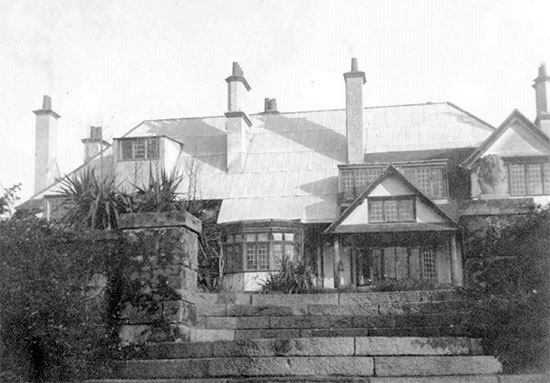
Headquarters 79th Field Hospital, Shillingstone, England, January-March 1945.
On 24 October 1944 the 79th moved to the first site of the bivouac early in the morning. The weather was excellent and the area, a flat-topped terrain, an ideal arrangement for tents (without concealment). Overall, the move was good, although many mistakes were made. The mess functioned at noon, the electricity worked by evening, but X-ray and surgery were somewhat slow. Ten (10) Medical Officers were assigned to the unit to fill the new T/O & E, although these Officers were not attached! Some of the new Officers assumed new and/or extra duties for the duration of the bivouac.
By 25 October the Second Hospital Platoon had set up the various tents for functioning, with expected ‘casualties’ to be processed the following day. Airplane rides were arranged for Officers and some Noncoms to observe the area. A night problem was held in map and compass reading. The next day the simulated casualties were processed by the First Hospital Platoon. The results were not good. Many Officers were unfamiliar with the cards, reports, equipment, and much more, so the afternoon was spent with familiarization of the above. News was received that the bivouac was to terminate on 31 October, and the organization was to move at T/O strength plus all equipment and general purpose vehicles. After mess, a five-mile hike took place in one hour and twenty-five minutes.
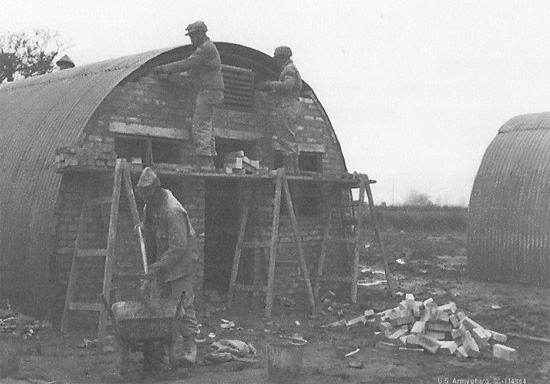
Construction of Nissen hutments in England. This was often the basis for housing, although, depending on circumstances, some organizations were established in existing British EMS buildings, in hospitals, in private billets, or simply in canvas tentage.
Change of Station:
It was learned that the 79th Fld Hosp would move to Fort Knox, Louisville, Kentucky (Armored Replacement Training Center & School; acreage 107,148; troop capacity 3,489 Officers and 57,048 Enlisted Men –ed) at 1430 hours, 7 November 1944 (Presidential Election Day –ed), with arrival expected to be around 1730 hours, 8 November. Freight cars were to assemble at the local railhead. Physically disqualified Officers were replaced by Captain Michael W. Giannini and 1st Lieutenant William W. Sears, both with the Medical Corps.
By 1100 hours, all freight cars with the equipment were sealed and the area cleaned, policed, and inspected by the Post Commander with excellent results. All troops were aboard the trucks at 1403 hours, allowing departure at 1450, 7 November (the 80th Field Hospital cars traveled with the 79th as far as St. Louis –ed).
After an uneventful night travel, the train arrived at Fort Knox at 1335 hours where it was met by Captain J. G. Economon (advance party –ed) and two other Officers, who brought vehicles (on loan from the 26th Medical Depot Company) to transport the men to their new station. On 9 November 1944, meetings took place with Lt. Colonel Franklin, CO of the Fort Knox Regional Hospital, and Lt. Colonel Meerin, XO. Lt. Colonel Sparks, Chief Nurse of Fort Knox Hospital, reported that the 79th Field Hospital’s Chief Nurse Captain Barns, ANC, had already joined Fort Knox on 7 November. Following the recent change of station and arrival of men and equipment, inspection took place by Fifth Service Command. This was an all-day procedure and results were not favorable. It was therefore arranged to plan parallel training for all Enlisted personnel. The results of the inspection revealed that many errors had been made. In general, supply and messing was good, but training was poor, and therefore a new program was to be set up to rectify the deficiencies, especially in map reading, mines, and booby traps. As from 14 November EM started parallel training at the Regional Hospital. Meanwhile packing, boxing, and crating of unit equipment was also started. The unit lost nine (9) EM to the 26th Medical Depot Company who had to move out in a hurry. Replacements were to be expected from Camp Barkeley, Abilene, Texas (Armored Division Camp and Medical Replacement Training Center: acreage 69,879; troop capacity 3,192 Officers and 54,493 Enlisted Men –ed). Wristwatches came in for distribution to Officers and NCOs according to the T/O & E.
Although expected several times, there was still no news about the Nurses’ contingent by 16 November. They seemed to be expected for early December.

Illustration showing Hospital staff caring for a patient …
Classes in basic medical training continued, packing and crating went along without difficulty (except that a spray gun was difficult to obtain –ed), and first hints for a possible overseas movement appeared when the Post Commander instructed the staff of the 79th Fld Hosp that all the automobiles and families of the Officers, NCOs, and EM were to depart for home. A last dental survey was started 20 November, followed by some familiarization lectures on mines and booby traps. There was still no word about the twelve (12) replacements expected from Camp Barkeley. Official orders were received from Washington DC, concerning the assignment of the ANC Officers to the unit on 1 December 1944.
On 25 November, eleven (11) EM reported from Camp Barkeley, Abilene, Texas. They included 1 clerk – 2 truck drivers – 4 surgical technicians – 4 medical technicians (one soldier went AWOL –ed).
On 2 December 1944, the four (4) first Nurses reported in from Camp Chaffee, Fort Smith, Arkansas (Armored Division Camp; acreage 75,028; troop capacity 2,491 Officers and 41,330 Enlisted Men –ed). It was nice to see the first ANC Officers join the organization! The remainder of the Nurses eventually arrived 4 December and were given an orientation talk at 0900 in the morning, immediately followed by due processing. The ANC Officers already participated in a twelve-mile rough hike at night. Fortunately for them, they only had to walk the first five (5) miles! Nurses were processed and received the appropriate clothing and equipment for overseas, took classes and saw POM films. On 6 December four (4) Officers, eighteen (18) Nurses, and seventeen (17) Enlisted Men went on bivouac. They were all to live in pup tents and mess with basic “C” rations and were only to carry two ward tents with them. Field classes were to include map and compass reading. Some Officer replacements were received 8 December and a formal inspection was held with all Officers from each Platoon accompanying the inspecting Officers to their respective units. Results were very good, and all EM were given their weekend passes. SOP for the 79th were finalized by 11 December and on 12 December the unit received its final orders indicating date and hour of departure to the Port of Embarkation. All TAT equipment was properly packed on 13 December and left for port on 15 December 1944.

Camp C-5, internal view of Officers’ barracks, Westminster, England, before crossing over to France, 23 March 1945.
Stations Zone of Interior – 79th Field Hospital
Camp Ellis, Illinois – 21 September 1944 > 6 November 1944
Fort Knox, Kentucky – 7 November 1944 > 15 December 1944
Camp Kilmer, New Jersey (Staging Area) – 18 December 1944 > 24 December 1944
Preparation for Overseas Movement:
The organization left Fort Knox at 2345 after a delay of ten (10) hours involving lack of transportation. The destination was Camp Kilmer, New Jersey.
The 79th Fld Hosp arrived at Camp Kilmer, Stelton, New Jersey (Staging Area for New York Port of Embarkation; acreage 1,815; troop capacity 2,074 Officers and 35,386 Enlisted Men –ed) at 0645, 18 December 1944, and was promptly billeted in Area 4, while the Nurses went to the Station Hospital. Processing for overseas movement was started immediately with a first lecture on military censorship. Further training continued the next day, with gas mask drill and abandon ship exercises conducted during a cold winter snow storm. Processing was completed by 20 December with shortages in clothing and equipment being remedied. All personnel obtained passes for New York City for 21 and 22 December, with alert orders being issued after return, and confinement to the POE area. The first dose of anti-typhus vaccine was given to all personnel. An advance party of 5 men went to the docks to check the accommodations for personnel on the boat, while the complete unit drilled in entraining and detraining.
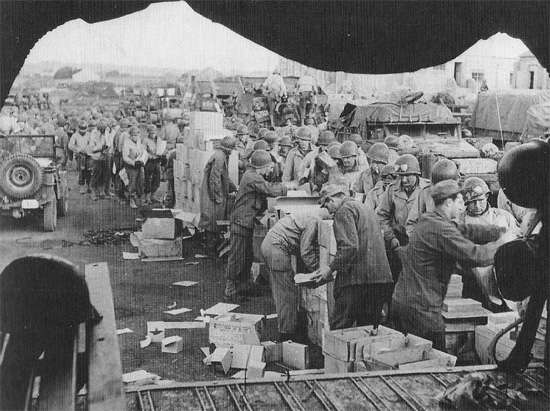
Staging Area “somewhere” in southern England; this is where US troops prepared for the Channel crossing. Troops line up for rations and equipment prior to departing for the Continent.
On 24 December, the 79th Fld Hosp departed Camp Kilmer at 0900 and boarded the USAT “Cristobal” at 1115 hours (docked up the Hudson River –ed). It was announced that Christmas Eve would be celebrated on board ship. On 25 December 1944, USAT “Cristobal” left the dock during the night and prepared for the Atlantic crossing (in convoy) during the late afternoon of 26 December 1944 amidst a dense fog. The second dose of anti-typhus vaccine was given on 28 December.
The crossing was largely uneventful. Moderate storms alternated with good and rough weather. Two submarine alerts were given with Destroyer Escorts dropping depth charges without any results. Part of the convoy (including the 79th) reached Plymouth, England, during the night of 7 – 8 January 1945.

Camp-Twenty-Grand, Le Havre Staging Area. Captain Roman is having a shave. Picture taken after the unit’s arrival, 26 March 1945.
United Kingdom:
After debarking and regrouping at the docks, the unit moved off by rail at 1900 hours, 8 January 1945, to their new destination. Arrival at Shillingstone, Blandford, Dorset, at 0115, 9 January 1945, the 79th was promptly billeted in Nissen huts located close to the railroad. Officers were housed in large lodges, and as no accommodation had been made available for the Nurses, they were temporarily set up in a couple of empty rooms. The reception and welcome party consisted of Officers and Enlisted Men of the 119th General Hospital who had prepared coffee and sandwiches. It was later learned that the organization was to be attached to the 802d Hospital Center.
On 12 January 1945, arrangements were made with the Surgeon, 802d Hosp Cen, Camp Blandford, Dorset, which consisted of the 22d – 119th – 125th – and 140th General Hospitals, to attach the personnel of the 79th Field Hospital for parallel training. While the expected stay would be between 10 and 14 days, eight (8) Medical Officers, three (3) Dental Officers, eighteen (18) Nurses, and ninety-eight (98) Technicians were attached to the 802d Hospital Center for training and TD. All equipment arrived on 19 January by rail. Unfortunately a problem developed because of a lack of storage space. With quite a number of personnel away on training, all EM were grouped together, and the remaining space in the Nissen huts was temporarily utilized for storage purposes.
The T/O & E vehicles were received by the organization on 5 February. As 20% was missing, it was promised that the balance would be supplied before departure for the Continent.

Illustration of surgery in the field …
Attachment to 802d Hospital Center, United Kingdom
15 January 1945 > 19 March 1945
The 79th Fld Hosp lost two (2) EM to Infantry OCS on 9 March 1945. The 18 ANC Officers who went on TD with General Hospitals returned to the organization and were now billeted in rooms made available in the home of Lord Chesterfield. The final allotment of authorized vehicles was received 15 March. Warning Orders were received indicating that the unit was to be prepared to leave upon six hours notice after 19 March 1945. A last inspection by representatives of the 802d Hospital Center took place on 16 March, and was concluded with positive results.
On 18 March 1945 orders were received that the 79th was reassigned from the Channel Base Section (Headquarters, Le Havre –ed) to the Normandy Base Section (Headquarters, Cherbourg –ed), Communications Zone, ETOUSA, per Troop Assignment Orders No. 26, dated 8 February 1945. The motor vehicle convoy, loaded with all TAT, left for Southampton on 19 March. The entire hospital organization departed Shillingstone, for Camp C-5, just outside Southampton, England. The trip was uneventful with the unit being transported from the railhead to the marshaling area by motor vehicles. Upon arrival on 21 March, it was learned that the motor vehicle party which preceded the main group had already left for the Continent!

A Medical Officer and a Nurse tend to a patient. The tent is a large Hospital Ward, 50 feet long, 16 feet wide, and 11 feet high, with the necessary upright poles, lines, and pins.
France:
The organization left Camp C-5, Southampton, by truck and proceeded to the its marshaling area where it boarded the S/S “Sobieski”, a Polish vessel. The trip across the Channel on 26 March 1945 was uneventful with debarkation taking place at Le Havre at 1000 hours. The men immediately entrucked for Camp “Twenty Grand”, France, while the Nurses went by motor convoy to the Nurses’ Assembly Area at Neufchâtel, France.
As from 1 April 1945, the 79th Fld Hosp was reassigned from the Normandy Base Section to the Continental Advance Section (CONAD, Headquarters, Dijon –ed) following Troop Assignment Orders No. 60.
By 6 April all equipment had arrived by way of LSTs going up the Seine River, and after unloading was promptly transferred onto railcars. On 8 April 1945, the 79th left its marshaling area (less the party with which the 18 Nurses traveled by “40 & 8” boxcars to their new destination as per Movement Orders No. 4-18, amended by Movement Orders No. 4-44, Headquarters Northern District, Normandy Base Section, Communications Zone, ETOUSA, dated 5 April 1945). The original destination, which was Kaiserslautern, Germany, was changed to Toul, France. The unit reached Toul at 1900 hours, 9 April 1945, without the motor vehicle party which had not been notified of the change in destination!

79th Field Hospital personnel and patients enroute by Hospital Train no. 71 from Toul, France, to Ludwigshafen, Germany, April 1945.
Stations in France – 79th Field Hospital
Camp Twenty Grand (Staging Area) – 26 March 1945 > 6 April 1945
Toul (Holding Area) – 9 April 1945 > 15 April 1945
On 10 April, five (5) ambulances containing all the ANC Officers and some equipment finally arrived at Toul. The balance of the motor vehicle party was eventually located in the vicinity of Darmstadt, Germany, together with the 57th Field Hospital where it was awaiting further orders… Meanwhile one Platoon of the 79th Fld Hosp was to be set up near an airfield located at Giebelstadt, Germany, where it was to be eventually joined by Third Platoon. With CONAD Headquarters now situated near Nancy, France, the unit’s Commanding Officer was now ordered to report to Colonel Cocke, CONAD Surgeon, somewhere beyond Mannheim, Germany. Orders were eventually received for the complete Hospital to set up near Mannheim in Germany, where it would function as a station hospital.
Germany:
On 12 April 1945, Colonel Harvey H. Gaynes (CO 79th Fld Hosp), made a reconnaissance of the area and located an excellent site for the Hospital, a functioning German Roman Catholic Hospital located at Ludwigshafen-Mundenheim containing 275 German civilian patients and 200 Nuns who operated the institution. The site was accepted and subsequent movement orders issued. The motor vehicle party would act as a holding group at the new site until the entire organization arrived. It reached its destination at 0730, 13 April 1945. The CO had meanwhile returned to Toul, France, where he arrived by 1500 hours. On 14 April all equipment was taken from the storage area at Toul and brought by truck to the loading platform of the local rail station to await the incoming Hospital Trains on which the equipment was to be moved. The more heavy items such as generators, refrigerators, x-ray equipment were to be moved in two or three 10-ton trailers (escorted by 6 EM) supplied by CONAD Headquarters. All other equipment and personnel would travel by Hospital Train from Toul, France, to Ludwigshafen, Germany.
Hospital Train No. 71 was loaded with equipment and carried 70% of all personnel, and departed for Ludwigshafen, Germany, at 0900 hours, 15 April 1945. The balance of the equipment and personnel moved by Hospital Train No. 75 the next day, 16 April 1945. Upon arrival the personnel were moved to the St. Marienkrankenhaus (nine-story building, built in the 1930s, well-equipped, and apparently not much affected by Allied bombings, it further contained small outer buildings which were converted for use as an Officers’ Club, supply, morgue, outpatients dispensary, motor pool, and garage –ed) at Ludwigshafen-Mundenheim, Germany. The German civilian patients were moved to Ludwigshafen City Hospital, between 16 and 17 April, while the first six (6) American wounded came in during the afternoon of 17 April 1945. The Stars and Stripes were raised on top of the building with a proper ceremony on 23 April 1945. German PWs constructed a wire fence around the hospital area, including the above-mentioned buildings under direct supervision of CONAD engineers.
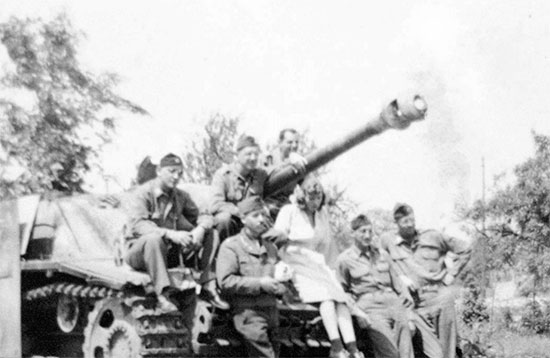
79th Field Hospital men posing on a wrecked German tank. Picture taken at Frankenthal, Germany.
Evacuation of patients requiring hospitalization in excess of thirty (30) days was no problem as the main station of 6 Hospital Trains was Ludwigshafen-am-Rhein.
The 29th Field Hospital opened at Rheinau on the Rhine River’s east bank on 4 May 1945. CONAD instructed them to take care of casualties on the east bank, while the 79th Field Hospital would treat any patients on the west bank of the Rhine. Since the 4th Medical Laboratory was located with the 29th Fld Hosp, all VD cases were transferred to them. In return, the 79th was to handle all contagious cases (they had more individual rooms available).
Stations in Germany – 79th Field Hospital
Ludwigshafen-Mundenheim (St. Marienkrankenhaus) – 15 April 1945 > 29 May 1945
8 May 1945 – V-E Day was a most happy day for all personnel, as the war with Germany was officially over! The event was celebrated with the formal opening of the Officers’ Club. Plans for Readjustment and Redeployment were received 9 May 1945, and ASR scores were started for each individual. Some changes were carried out between 13 and 17 May. Two rooms for the Military Police were kept, and closed wards for possible NP cases established. The Adjusted Service Ratings were made out by 18 May, with the minimum number of points set at 85 for possible discharge (sofar only 2 EM fell in this category –ed). In the meantime three (3) Enlisted Men reached over eighty-five points, and two (2) married Nurses expressed their desire not to serve in the South Pacific. Instructions were received that patients would only be admitted until midnight, 27 May 1945, after which the Hospital was to be officially closed!
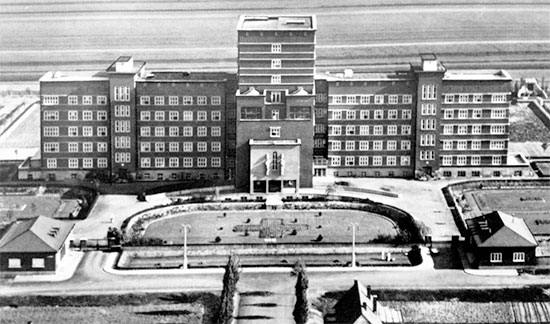
Aerial view of St. Marienkrankenhaus, Ludwigshafen, Germany, spring 1945. The unit was to remain here from 15 April 1945 until 29 May 1945.
Final Operations in Europe:
On 28 May 1945, the Hospital’s census stood at 248, and those cases were either to be discharged to duty or to be transferred to other medical installations. More personnel were leaving the organization. By 29 May 1945, ALL patients, remaining personnel, and supplies had been packed by each respective department, and all excess equipment turned in. All sections were ready, having packed, with supplies and equipment separated by Platoon, and were awaiting further orders. Two ANC Officers joined the 79th as replacements, and one Officer was transferred to the 164th General Hospital. The latter was replaced by an EENT Officer of the same Hospital.
A formal inspection by Colonel Stubblebine, Chief of Staff, CONAD Headquarters, and Colonel Cocke, Surgeon CONAD was completed with excellent results. Any shortages in supplies were meanwhile requisitioned. Promotions followed involving a number of ANC Officers (2d Lieutenant > 1st Lieutenant –ed). On 9 June another four (4) Nurses were promoted to the rank of 1st Lieutenant, followed by two (2) MC Officers. An Officer Anesthetist, reported for duty from the 221st General Hospital. On 14 June 1945, a mass promotion of Enlisted Men took place as a reward for the excellent work they accomplished while serving with the organization.
On 15 June, orders were received from the S-3, CONAD Headquarters, that the 79th Field Hospital was to be at the marshaling area, Delta Base Section, by 19 June 1945. CONAD was meanwhile making every possible attempt to secure rail transportation for this new move. On 16 June final orders were received from CONAD to proceed to the next destination, as per Letter, Headquarters, CONAD, File AG 370.5, dated 15 June 1945. All equipment was eventually packed in nine (9) freight cars, the Enlisted personnel would travel in eight (8) “40 & 8” cars, one (1) coach would be reserved for male Officers, and one (1) coach would be for the Nurses.
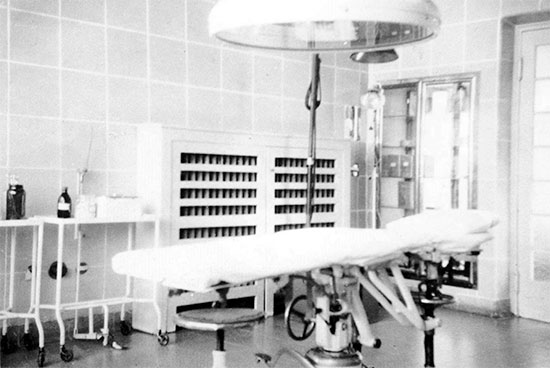
Picture illustrating one of the unit’s modern Operating Rooms while stationed at St. Marienkrankenhaus, Ludwigshafen, Germany.
Departure from the St. Marienkrankenhaus took place at 0800, 19 June 1945, by motor vehicle. All personnel were being transported to the Ludwigshafen rail station. A strict non-fraternization policy had been in effect and at no time did the men of the 79th seem to fraternize with the local population (the ban on fraternization with children was lifted 11 June, and global orders were gradually revised, lifting the ban which became effective 1 October 1945 –ed).
The train arrived at the Arles Staging Area # 3, Southern France, at 1130 hours, 21 June 1945. The Hospital was back in France now. After having been served a meal from the train’s own kitchen car, the equipment was reloaded onto waiting trucks and brought to the proper staging area where the Officers and the Enlisted Men had been assembled. The Nurses continued on to Marseille, France, where they were finally staged while being processed and billeted with the 235th General Hospital. The motor convoy which had left Mundenheim a day later arrived 23 June bringing in all TAT equipment. The organization was together once again…
Sun, extreme heat, dust, dirt, and wind did not contribute to a happy life at the Staging Area. The Camp itself was run by the 66th Infantry Division, an unfortunate job for inexperienced people! Many niceties, although advertised were simply not available; there were showers somewhere but no transportation to them; neither beer nor coke were served, although promised. The overall picture looked bad…
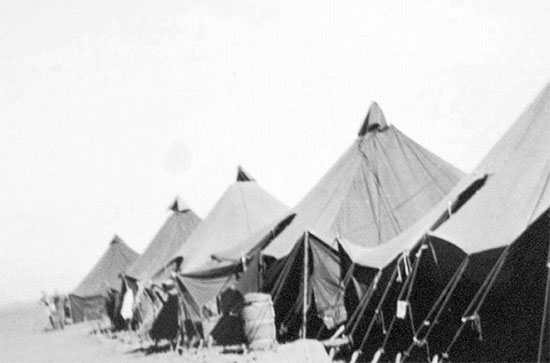
Arles Staging Area # 3, Southern France, where the 79th Field Hospital was awaiting redeployment to the South Pacific Area. Period July-August 1945.
On 27 June 1945 a Captain Adalman reported for duty; he was to replace an Officer who had over 90 points. Finally orders were received to turn in all the vehicles. 2 July passed and the organization was still without any information concerning preparation of their future move. On 7 July 1945, all personnel received their first inoculation against cholera, and an American Red Cross Representative reported for duty. Then it was back to daily military life and reality, gas mask drills were held, lectures given, and three (3) Officers and ten (10) Enlisted Men were selected for leave and furlough at the French Riviera (US Army French Riviera Recreational Area, with over 18,000 accommodations reserved for Officers – Cannes, and for EM – Nice –ed). All vehicles were turned in on 10 July, and four (4) days later the second and final cholera immunization shot was given to all personnel. Vocal orders were received instructing the organization to start loading on 25 July. Five (5) ANC Officers were promoted to 1st Lieutenant on 17 July 1945. The organizational equipment was effectively loaded on board ship on 26 July. All personnel records were meanwhile inspected by an AG Team from the Delta Base Section. Another Officer joined the 79th replacing Captain Roman who had collected enough points to go home. Some Officers were transferred to the 99th General and the 116th General Hospitals.
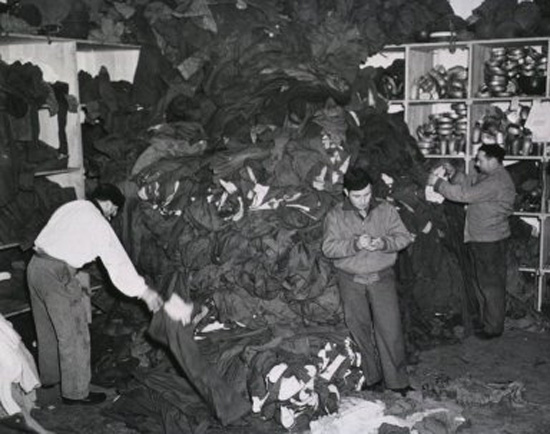
Hospital personnel sort out clothing and individual equipment from a salvage heap. It was the organization’s responsibility to make sure that everything that was brought in by patients was classified, inventoried, cleaned, and ready to equip patients being returned to duty or discharged from the service.
On 3 August, the unit was warned that the tentative date of departure would be 10 August 1945, and the vessel was the USS “General W. P. Richardson”. All TAT equipment was in order and ready for shipment as from 5 August 1945. Two (2) EM from the 3d General Hospital were transferred to the organization on 9 August.
About 2315 hours, 9 August 1945, an “unauthorized report” came in announcing that the war with Japan was over! This caused quite an uproar in the whole camp, although the news was not confirmed. After locating some missing equipment, including the shower unit, all equipment was loaded and aboard three different ships. On 19 August, Captains John Garby and John Delany were promoted to Major
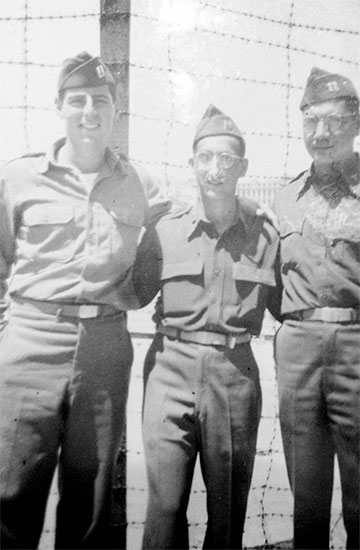
Marseille Port of Embarkation, Southern France, July 1945. From L to R: Captains Henry B. Wolfe, DC; Roman, MC; and S. Leventhal, MC; some time prior to leaving for the Zone of Interior.
Return to Zone of Interior:
The organization entrucked at Camp Arles at 0245, 11 August 1945, and were taken to the St. Martin-de-Crau railhead. They waited there from 0300 to 0815 hours for transportation to the Port area. The group finally arrived at the Marseille Staging Area at 1130 to board the USS “General W. P. Richardson” (AP-118) around 1430 hours. A first meal was served aboard ship in the evening, after which the transport vessel gradually pulled out of Marseille harbor for the Mediterranean. At the time everyone was still wondering what the final destination would be…
Stations in France – 79th Field Hospital
Arles (Staging Area) – 21 June 1945 > 11 August 1945
The very first two days were uneventful, passing “The Rock” (Gibraltar) around noon of 13 August. On 14 August 1945 the skipper announced at 2300 hours that Japan had given up and peace had been signed and declared. The news resulted in much celebration including firing of all guns on the ship. Everyone was overjoyed, although the organization’s future was still undetermined! A welcome surprise announcement was made at 1620 hours, 15 August 1945, that the USS “General Richardson’s” destination had now been changed to Boston, Massachusetts!
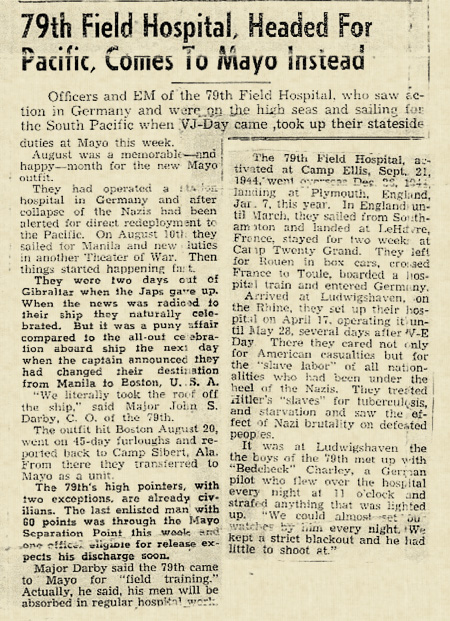
Copy of the “Mayo News”, Volume II, No. 8, Galesburg, Illinois, dated 9 November 1945, announcing arrival of the 79th Field Hospital.
Zone of Interior:
The USS “General W. P. Richardson” arrived at Boston harbor after an uneventful trip at 1000 hours, 20 August 1945 and her passengers proceeded immediately to Camp Myles Standish, Boston, Massachusetts (Staging Area for Boston Port of Embarkation; acreage 1,485; troop capacity 1,298 Officers and 23,100 Enlisted Men –ed). The 79th Field Hospital was now classified as a Category II unit (in principle to be redeployed to the Pacific –ed) and all personnel received 30 days leave or furlough with instructions to reassemble at Camp Sibert, Attalia, Alabama (Chemical Warfare Replacement Training Center; acreage 37,394; troop capacity 1,299 Officers and 22,738 Enlisted Men –ed). On 20 September, all personnel received a 15-day extension to leave and furlough. Two (2) Nurses received promotions to 1st Lieutenant. By mid-October 1945, there was only a diminishing group of Officers and Enlisted Men left as some personnel had already been discharged from the service. This included the Nurses and other persons not qualified for discharge who were to be either reassigned or remain with the unit.
On 17 October 1945, the organization was notified by Army Service Forces, Headquarters, Fourth Service Command, that the 79th Fld Hosp had been relieved from assignment for redeployment training pending further instructions. Yet, it remained assigned for preparation in view of extended field service without change of station. As a result, the 79th was now attached to the Army Service Forces Training Center, Camp Crowder, Neosho, Missouri (Signal Corps Training Center; acreage 43,007; troop capacity 1,988 Officers and 40,642 Enlisted Men, CO, Brigadier General Charles M. Milliken, June 1945 – March 1946 –ed) for personnel supply … Thirteen (13) Medical Officers and ten (10) ANC Officers reported for TD from their home stations after a 45-day leave, followed by eighty-three (83) Enlisted Men. All other male Officers had been honorably discharged, and more Officers were eligible for discharge including a considerable number of Enlisted personnel.
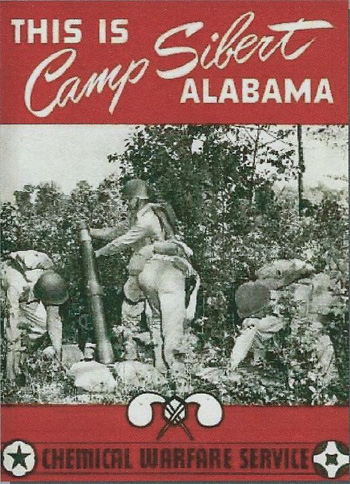
1943 Booklet describing Camp Sibert, Attalia, Alabama and its role in World War Two. A 37,000-acre installation, the camp was initially established in spring of 1942 for use as a Chemical Warfare Service Replacement Training Center.
On 19 October 1945, orders were received stating that the organization was to be held in abeyance at its current station in a more or less “inactive” status until further decision would be taken by higher authority … the following day it was decided by the Post Commander that the unit’s CO, Lt. Colonel Harvey E. Gaynes, MC, O-346074, could be relieved and temporarily replaced by the next higher ranking Officer, Major John S. Darby, who was soon expected to return from California (effective 23 October 1945 –ed). More Officers became eligible for discharge. It was finally decided that the 79th Field Hospital personnel was to be attached to the William J. Mayo General Hospital, Galesburg, Illinois (designated US Army General Hospital by War Department General Orders No. 48, dated 24 August 1943, ready for operation 1 February 1944, bed capacity 1,855 –ed) before 1 November 1945 – the organization departed 1 November, arriving at its new station 2 November 1945, where it was met by a band, Colonel Krafft, Commanding Officer Mayo General Hospital, and given a hearty welcome followed by supper (on 28 November 1945, the men who were not eligible for overseas duty were transferred out to the 3613th SCU, Mayo General Hospital, leaving the original 79th Fld Hosp unit with only 8 Officers and 9 Enlisted Men –ed).
Commanding Officers – 79th Field Hospital
Lt. Colonel Harvey E. Gaynes – 21 September 1944 > 23 October 1945
Major John S. Darby – 23 October 1945 > NA
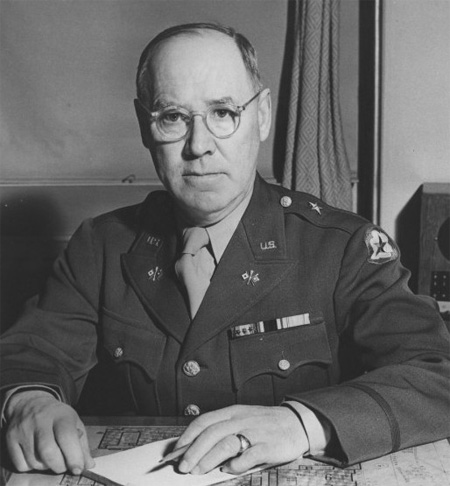
Photograph of Brigadier General Charles M. Milliken (1888-1959), Commanding General Camp Crowder, Neosho, Missouri, ZI.
The MRC Staff wish to thank Mitch Leventhal, son of Captain Sydney Leventhal, MC (O-524876) who served with the 79th Field Hospital in the European Theater of Operations for providing them with a number of pictures illustrating the unit’s medical personnel and installations. We are still looking for a complete personnel roster of the Hospital as well as additional pictures and documents illustrating the unit during its WWII service years in the Zone of Interior and the European Theater. Also missing is information about its final active service period spent with Mayo General Hospital. Thank you.
